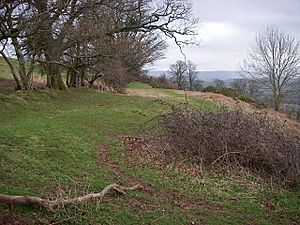Slwch Tump facts for kids
Slwch Tump, also known as Slwch Camp, is an ancient hillfort. It was built during the Iron Age in Wales. You can find it near the town of Brecon in Powys.
What is Slwch Tump?
This old fort sits on a hill made of sandstone. The hill is about 807 feet (246 meters) high. It is located about 0.8 miles (1.3 km) east of where two rivers meet. These rivers are the Usk and the Honddu. You can visit the hillfort using a public path. This path connects to Slwch Lane and goes around the fort's outer wall.
Exploring the Hillfort
Slwch Tump is smaller than another nearby hillfort called Pen-y-crug. It has a shape that is not perfectly regular, but it's mostly like a rectangle. It measures about 187 meters long and 242 meters wide. The fort has one main wall, called a rampart, that goes all the way around it.
In 1845, a writer named Samuel Lewis described it. He said it had two ditches for defense. Today, some parts of these ditches are gone. The main entrance to the fort faces the north-west, towards Brecon.
Over time, hedges and trees have grown around the fort. This makes it a bit harder to see its original shape. Inside the area of the hillfort, you can also find old, unused quarries. These were places where people dug for building stones.
The Story of Saint Eluned
For a long time, a small church stood at Slwch Tump. This church marked a special spot. It was believed to be where Saint Eluned was killed. Eluned was a princess from the 5th century. She was one of the daughters of King Brychan of Brycheiniog.
Eluned was a Christian. She did not want to marry a prince who followed different beliefs. So, she ran away from him. When she reached Slwch Tump, the local lord let her build a small home there. She lived peacefully in her cell until the prince found her. As she tried to escape again, he used his sword and cut off her head.
Legend says that a spring of water appeared right where she died. Her small home then became a church. This church stayed on the site, even when it became old and ruined. It was finally gone by the year 1698. Before a time called the Reformation, people believed the spring had healing powers. They also thought miracles happened there.



